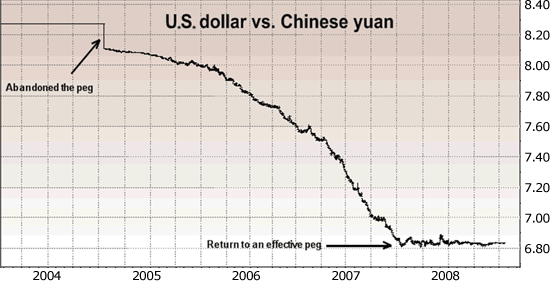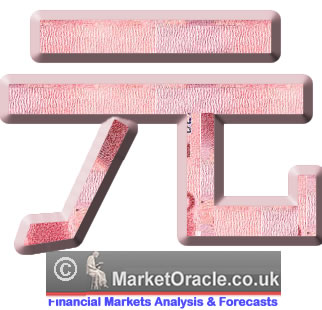China's Unfair Currency Advantage, 29% of International Reserve Assets
Currencies / China Currency Yuan Jul 20, 2009 - 04:51 AM GMT Bryan Rich writes: China’s the largest country in the world by population, the third-largest economy and the third-largest exporter. It’s also the owner of over $2 trillion in foreign currency reserves.
Bryan Rich writes: China’s the largest country in the world by population, the third-largest economy and the third-largest exporter. It’s also the owner of over $2 trillion in foreign currency reserves.
And in the worst global recession since the Great Depression, it’s the only large economy that’s growing! But it’s also the most restricted and least transparent of the bunch.
So how did China amass such a position in the global economy? And how does one country gather 29 percent of all international reserve assets?
The common notion is that it all boils down to trade … countries running trade surpluses (net exporters) accumulate wealth from countries running trade deficits (net importers).
But for China, reserve accumulation and economic growth has as much or more to do with its exchange rate policy as it does with huge trade surpluses …
You see, exports have been, and are, the key driver of growth in China. And when dollar-based investments and revenues flow into China, converting those inflows to the yuan puts upward pressure on China’s currency. This upward pressure threatens to strengthen the yuan, making it less competitive on a global stage for trade.
 |
| China needs a weak currency to keep its exports high and factories humming. |
China doesn’t want that … China needs a weak yuan to continue exporting its way to growth. That’s why the Chinese central bank manages the value of its currency.
To offset the local demand to exchange U.S. dollars for yuan, the central bank takes the other side — selling yuan and buying dollars. This keeps the exchange rate stable, and China builds vast amounts of dollar reserves.
The Weak Currency Advantage …
For a decade, China maintained a fixed exchange rate policy — the yuan was pegged against the dollar. One U.S. dollar bought 8.27 yuan. This allowed China to undercut the rest of the world, churning out cheap commoditized goods, competing on one thing: Price.
Consequently, the Chinese economy shot up from $728 billion to $2.3 trillion.
But in 2005, China changed its currency policy. It abandoned the peg.
After political tensions rose between China and its key trading partners, namely the U.S., China adopted a “managed float.” Under this policy China agreed to let the yuan trade in a defined daily trading band, while gradually allowing it to appreciate. This was China’s way of pacifying its trading partners while maintaining complete control over its currency.
Over the next three years the Chinese yuan climbed 17 percent against the dollar, enough to ease a politically sensitive issue, but far less than the relative economic growth would warrant. In fact, China’s economy grew by 43 percent while the U.S. economy grew only 10 percent.
If China’s currency was determined by market forces, the relative outperformance would:
- Drive investments into China …
- Drive up the value of the yuan …
- And drive down the value of the U.S. dollar.
This currency dynamic would slow exports in China and make exports in the U.S. more appealing. A natural balancing mechanism.
But not only has China been very slow to let the yuan strengthen, thus protecting its export model, it’s virtually put the brakes on currency appreciation altogether since the inception of the global financial crisis.
The chart below shows the move from a peg, to a managed float, and back to what is effectively a pegged exchange rate …

Source: Bloomberg
China has been moving, however, on another area of its currency policy — the international use of the yuan in trade.
Until this month, trading of yuan had been heavily restricted by the government — authorized only within mainland China and only through China’s agent banks.
Therefore, Chinese companies could not settle foreign trade in yuan. Most international trade was priced in U.S. dollars and settled in U.S. dollars, creating the burgeoning foreign currency reserves I mentioned above.
Now for the first time, China is relaxing restrictions and allowing the yuan to trade offshore with select Asian neighboring countries. This is a first step in China’s attempt to temper growth in its foreign currency reserves and to make the yuan a globally traded currency.
But the yuan lacks appeal as an international currency. After all, there are hurdles associated with managing currency risk of the yuan, especially because the government controls its value!
China’s Unfair Advantage …
As a currency manipulator, China is in violation of WTO rules. Yet its trade partners have been hesitant to levy that charge. Instead, led by the U.S., they they’ve taken a diplomatic approach, encouraging China to move toward a market determined (or free-floating) exchange rate.
 |
| A manipulated yuan could result in skyrocketing tariffs on Chinese goods. |
But China doesn’t seem to have any intention on giving up its key mechanism for controlling its competitive advantage on the world stage. Why would they?
Moreover, China is now furthering its efforts to create and protect its advantage.
This time, though, its trading partners are putting up a fight. Both the U.S. and Europe recently filed a complaint with the WTO. They accused China of limiting exports of raw materials to the rest of the world, giving an unfair advantage to its domestic manufacturers.
And here’s my point: Many perceive China to have the position of strength over the world economy. But with an economy so dependent on a manipulated currency and maintaining unfair trade advantages, resistance from global trading partners could reverse that perception very quickly.
Remember, it wasn’t too long ago that a couple of U.S. Senators were passing around a bill to hit Chinese goods with a 27.5 percent tariff!
Regards,
Bryan
This investment news is brought to you by Money and Markets . Money and Markets is a free daily investment newsletter from Martin D. Weiss and Weiss Research analysts offering the latest investing news and financial insights for the stock market, including tips and advice on investing in gold, energy and oil. Dr. Weiss is a leader in the fields of investing, interest rates, financial safety and economic forecasting. To view archives or subscribe, visit http://www.moneyandmarkets.com .
Money and Markets Archive |
© 2005-2022 http://www.MarketOracle.co.uk - The Market Oracle is a FREE Daily Financial Markets Analysis & Forecasting online publication.



